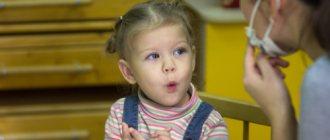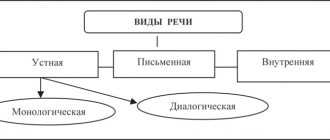Features of development of children with severe speech impairments
The main feature of speech development disorders identified in childhood is the reversibility or minimization of the accompanying consequences. They can be both physiological and pathological in nature. Children with SLI do not have a primary intellectual disability, their hearing is preserved, but they have serious speech defects that have a negative impact on the development of the psyche - slurred speech, incorrect pronunciation of sounds, insufficient degree of mastery of the sound composition of a word, which can lead to impairment in the development of reading skills and letters. Despite the fact that many children perfectly understand speech addressed to them, they themselves do not have the opportunity to communicate with others through verbal speech. In some cases, these and many other defects are serious obstacles to full communication.
The most common severe speech disorders are alalia, aphasia, rhinolalia, and dysarthria. Some forms of stuttering can also be classified as TSD (provided that, due to this defect, the child cannot study in a regular school). As a rule, this includes stuttering combined with GSD (general speech underdevelopment).
Features of children's speech activity have a direct impact on the sensory, intellectual and affective-volitional spheres, namely, on the process of their formation. One can note an insufficient degree of stability of attention and limited possibilities for its distribution. Low mnemonic activity can be combined with slow development of other mental processes. Having full-fledged prerequisites for mastering mental operations accessible for their age, children are deprived of this opportunity due to a lag in the development of verbal and logical thinking; they are barely able to master the skills of analysis and synthesis, comparison and generalization.
The developmental features of children with severe speech impairments are also expressed in the form of somatic weakness and delayed development of locomotor functions. They are also characterized by some delay in the development of the motor sphere, expressed in insufficient coordination of movements, low speed and dexterity in their execution. The most difficult thing is to perform movements in accordance with verbal instructions due to insufficient coordination of the fingers and the level of development of fine motor skills.
Children with SLI have noticeable deviations in the emotional-volitional sphere: they are characterized by frequent changes of interests, lack of observation, low motivation, negative perception, lack of confidence in their own capabilities, high levels of irritability and aggression, touchiness, problems in communication and establishing contacts with others. Such violations are also expressed in difficulties in the formation of self-regulation and self-control.
The above developmental features of children with severe speech impairments cannot be overcome spontaneously. They require targeted correctional work under the guidance of highly qualified specialists. The main task of parents in this case is not to ignore the problem, but to provide all possible assistance in solving it.
In addition to speech correction, classes with specialists are aimed at developing memory, attention, thinking, general and fine motor skills. With the right approach, children are able to master oral and written language, as well as many other skills necessary for successful learning at school and communicating with peers.
Features of development of children with severe speech impairments
5 (100%) 1 votes
Article:
Dysarthria
Dysarthria is a disorder of the pronunciation side of speech that occurs as a result of organic damage to the central nervous system.
The main distinguishing feature of dysarthria from other pronunciation disorders is that in this case it is not the pronunciation of individual sounds that suffers, but the entire pronunciation aspect of speech. Dysarthric children have limited mobility of speech and facial muscles. The speech of such a child is characterized by unclear, blurred sound pronunciation; His voice is quiet, weak, and sometimes, on the contrary, harsh; the breathing rhythm is disturbed; speech loses its fluency, the pace of speech can be accelerated or slowed down.
The causes of dysarthria are various harmful factors that can act in utero during pregnancy (viral infections, toxicosis, pathology of the placenta), at the time of birth (prolonged or rapid labor causing hemorrhage in the baby’s brain) and at an early age (infectious diseases of the brain and brain). membranes: meningitis, meningoencephalitis, etc.).
Dysarthria can occur in both severe and mild forms. The severe form is most often considered within the framework of cerebral palsy and is its component. Children with severe dysarthria receive comprehensive speech therapy and medical care in special institutions: kindergartens and schools for children with severe speech impairments and for children with musculoskeletal disorders.
In kindergartens and general schools there may be children with mild degrees of dysarthria (other names: erased form, dysarthric component). These forms manifest themselves in a milder degree of disturbance of the movements of the organs of the articulatory apparatus, general and fine motor skills, as well as in violations of the pronunciation side of speech - it is understandable to others, but unclear.
Children with erased forms of dysarthria do not stand out sharply among their peers, and do not even always immediately attract attention. However, they have some peculiarities. So, these children speak unclearly and eat poorly.
They usually do not like meat, bread crusts, carrots, or hard apples as they find it difficult to chew. After chewing a little, the child can hold the food in his cheek until adults reprimand him. Often parents make concessions to the baby - they give soft food so that he can eat. Thus, they, unwittingly, contribute to a delay in the child’s development of movements of the articulatory apparatus. It is necessary to gradually, little by little, teach the child to chew solid food well.
It is more difficult for such children to develop cultural and hygienic skills, which require precise movements of various muscle groups. The child cannot rinse his mouth independently, since his cheek and tongue muscles are poorly developed. He either immediately swallows the water or pours it back. Such a child needs to be taught to puff out his cheeks and hold the air, and then pump it from one cheek to the other, retract his cheeks with his mouth open and lips closed. Only after these exercises can you teach your child to rinse his mouth with water.
Children with dysarthria do not like and do not want to fasten their own buttons, lace up their shoes, or roll up their sleeves. You can't achieve anything here with orders alone. Fine motor skills should be gradually developed using special exercises. You can teach your child to fasten buttons (first large, then small) on a doll’s clothes or on a removed dress or coat. At the same time, the adult not only shows the movements, but also helps to make them with the hands of the child himself. After such training, children will be able to fasten buttons on clothes they are wearing.
To train the ability to lace shoes, various shapes (square, circle, etc.) cut out of thick cardboard are used. Holes are made along the edges of the figure at a distance of 1 cm from each other. The child must sequentially thread a long cord with a metal end through all the holes over the edge, as if stitching the edges.
To ensure that your child’s interest in the exercises does not wane, you can stick some picture in the middle of the figure and say that by threading the colored cord correctly, the child will make a toy in this way and will be able to give it to anyone he wants. Then he is asked to lace up his shoes, first taken off his feet, then directly on his feet.
Dysarthric children also experience difficulties in visual arts. They cannot hold a pencil correctly, use scissors, or regulate the pressure on the pencil and brush. In order to teach a child how to use scissors faster and better, you need to place his fingers together with your own in the rings of the scissors and perform joint actions, consistently practicing all the necessary movements. Gradually, developing fine motor skills of the hands, the child develops the ability to regulate the strength and accuracy of his movements.
Such children also have difficulty performing physical exercises and dancing. It is not easy for them to learn to correlate their movements with the beginning and end of a musical phrase, and to change the nature of movements according to the beat. They say about such children that they are clumsy because they cannot clearly and accurately perform various motor exercises. It is difficult for them to maintain balance while standing on one leg, and they often do not know how to jump on their left or right leg. Usually an adult helps a child jump on one leg, first supporting him by the waist, and then by the front with both hands, until he learns to do it independently.
Motor skills disorders in children require additional individual lessons in special institutions and at home. The child’s education is carried out in different areas: the development of motor skills (general, fine, articulation), correction of sound pronunciation, formation of the rhythmic and melodic side of speech and improvement of diction. In order for a child to develop strong skills in the entire motor sphere, it takes a long time and the use of a variety of forms and teaching methods. To achieve results as quickly as possible, the work should be carried out together with a speech therapist; consultations with a psychoneurologist and a specialist in physical therapy are also necessary.
Dislalia
Functional dyslalia (Greek dys - disorder + Greek lalia - speech) is a violation of sound pronunciation in the absence of organic disorders in the structure of the articulatory apparatus.
Causes of functional dyslalia:
- Incorrect education of a child’s speech in the family. Sometimes adults “babble” with the baby for a long time. As a result, the development of correct sound pronunciation may be delayed for a long time.
- Functional dyslalia can occur by imitation. As a rule, constant communication with young children who have not yet formed the correct sound pronunciation is harmful for the child. Often a child imitates the distorted sound pronunciation of adult family members. The development of children's speech is also harmed by constant communication with people whose speech is unclear, too hasty, or with dialectal features.
- Bilingualism in the family does not always have a good effect on the development of children’s speech. When speaking different languages, a child often transfers the pronunciation features of one language to another.
- Pedagogical neglect, when adults do not pay attention to the child’s sound pronunciation and do not correct his mistakes.
- Defects in sound pronunciation may be caused by underdevelopment of phonemic hearing. In this case, the child has difficulty in differentiating sounds that differ from each other by subtle acoustic features, for example, voiced and dull, soft and hard, whistling and hissing;
- Another cause of functional dyslalia may be insufficient mobility of the organs of the articulatory apparatus: tongue, lips, lower jaw. It can also be caused by the child’s inability to hold the tongue in the desired position or quickly move from one movement to another.
- Functional dyslalia can also be caused by hearing loss. Most often, there are difficulties in differentiating hissing and whistling sounds, voiced and voiceless consonants.
- Another cause of functional dyslalia may be insufficient mental development of the child. In oligophrenic children, in half of the cases there is a violation of sound pronunciation;
Mechanical (organic) dyslalia is a violation of sound pronunciation caused by defects in the peripheral speech apparatus (organs of articulation).
Causes of mechanical (organic) dyslalia:
- Anomalies of the dental system: prognathia, i.e. protrusion of the upper jaw forward due to its excessive development compared to the lower jaw; progeny, i.e. protrusion of the lower jaw compared to the upper; open bite, i.e. a gap remains between the teeth of the upper and lower jaws when they close; lateral open bite (left-sided, right-sided or bilateral), incorrect structure of the teeth, for example, with large gaps between the teeth, the tongue can stick into them at the time of speech, distorting sound pronunciation.
- Incorrect structure of the palate. A narrow, high, low, flat palate prevents the correct articulation of many sounds.
- Thick lips, often with a pendulous lower lip, or a shortened, inactive upper lip make it difficult to clearly pronounce labial and labiodental sounds.
- Mechanical dyslalia is often caused by a shortened frenulum of the tongue (hyoid ligament).
- Mechanical dyslalia can also be caused by a tongue that is either too large or too small.
When to contact a speech therapist
- Vocal reactions appear in a child from the moment of birth: screaming and crying.
- 2-3 months. At this age, the child begins to hum and babble. The silence of a child should cause concern in parents.
- 9-10 months. An understanding of adult speech and the first words are formed. But at this age, the child reacts not so much to the speech of adults, but to the situation and intonation.
- 11-12 months. A reaction to the words themselves appears, regardless of the speaker’s intonation and the surrounding situation.
- 1-1.5 years. The child’s situational speech develops. The same words can have different meanings, depending on the situation. The child often confuses sounds and distorts them.
- 1.5-2 years. A period of intensive development of understanding of adult speech, the number of words quickly increases, and the first phrases appear. The words are already generalized and not situational in nature. It is very important during this period to provide the necessary volume of speech for imitation. Brain cells are maximally ready to learn words and the rules for combining them into phrases.
- 2-3 years. Formation of the grammatical structure of speech, accumulation of vocabulary (by the age of 3, the child already knows from 300 to 1000 words). If by 2.5 years the child does not form phrases, then it is necessary to contact a speech therapist.
- In the period from 3 to 5 years, it is advisable to consult a speech therapist in any case. At this age, many children pronounce sounds incorrectly, but impaired sound pronunciation can be either a consequence of natural physiological causes or a symptom of speech pathology. Early detection of speech development anomalies and timely referral to specialists is very important.
- By the age of 5, a child should be able to form phrases correctly and pronounce all speech sounds!
- A person’s speech develops throughout his life, so a speech therapist can also help adults.
ARTICULATIVE GYMNASTICS
- “Fence” - smile broadly and show clenched teeth (the upper teeth sit exactly on the lower ones). Hold for 5-7 seconds.
- “Elephant” – stretch out the lips in a “tube” (teeth clenched). Hold for 5-7 seconds.
- Alternate exercises N1 and N2
- “Naughty tongue” - spank the wide flat tip of the tongue with your lips, pronouncing “five-five-five.” Repeat 3 times.
- “Pancake on a plate” - place the wide flat tip of your tongue on your lower lip, saying “five” once. The tongue should not move. The mouth is slightly open. Hold for 3-10 seconds.
- “Brush your teeth” - open your mouth wide, smile showing your teeth. Then the tip of the tongue “cleanses the teeth” from the inside, moving it left and right (first the lower ones, then the upper ones). The tip of the tongue should be behind the teeth. The lower jaw does not move. Repeat 5-6 times.
- “Delicious jam” - lick your upper lip from top to bottom with the wide flat tip of your tongue. In this case, the lower teeth should be visible (the lower lip is pulled down, the teeth do not bite the tongue).
- “Painter” - open your mouth wide, smile, showing your teeth. Use the tip of your tongue to “paint” the ceiling, moving it back and forth across the hard palate (to the teeth and further towards the neck). The tongue should not pop out behind the teeth, come off “from the ceiling” and move left and right. The lower jaw should not move.
- “Horse” - open your mouth slightly, smile, showing your teeth. Click your tongue slowly, quickly, quickly, slowly, with short pauses to rest. Try not to move your lower jaw.
- “Swing” - open your mouth wide, stick out your tongue and move it up and down. The lower jaw does not move, the teeth do not bite the tongue.
- “Chocolate” - open your mouth slightly and lick your lips with your tongue in a circle clockwise and counterclockwise. Repeat 2-3 times.
- “Candy” - rest the tip of your tongue on your cheek (lips are closed and teeth are apart) - “hide the candy behind your cheek”, press lightly with your finger on the cheek and tongue (the tongue resists pressure)
- “Sick finger” - place the wide, flat tip of your tongue between your lips (i.e., your lips lightly hold the tip of your tongue) and blow on your finger. The air should flow through the middle through the small gap between the tongue and the upper lip. Take a deep breath and long, smooth exhale.
- “Turkey” - open your mouth slightly and quickly move the wide tip of your tongue back and forth along your upper lip, pronouncing a sound close to “bl-bl-bl”. Continue the sound for 5-7 seconds, first taking a deep breath.
Take a hearing test online
What does a hearing test tell you?
An online hearing test allows you to quickly and easily determine your hearing status. In just 3 minutes you can determine its spiciness. The result of the hearing test is called an “audiogram” and is an indication for doctor’s prescriptions.
We suggest the following hearing tests: signs of hearing loss; online frequency hearing test; hearing test in noise; speech recognition; modeling signs of hearing loss.
Take a hearing test
Development of speech with hearing loss: ways to teach children
Experts identify 4 different approaches to developing the speech of a child diagnosed with hearing loss. They are used with varying frequency depending on the characteristics of each little student. If, in addition to hearing loss, he also suffers from decreased vision, it is necessary to use cutaneous and motor methods of learning. Visual and auditory are much more common. Even at stage 4 of hearing loss, a properly selected hearing aid will help you distinguish sounds, and it will be much easier to repeat them.
If hearing loss is not addressed at an early age, problems may arise in speech development. This can be easily avoided if you approach training comprehensively. From a very early age, parents and, if possible, teachers should work with the child.
Even if hearing loss is severe, it is always possible to teach a child to reproduce speech based on visual perception. The baby observes the facial expressions of the parents or teacher during the conversation and adopts their experience. The specialist teaches him to repeat the movements of his lips and tongue, breathe correctly and pronounce individual sounds. This contributes to the gradual development of speech.
In classes on speech development, the teacher finds an approach to the student: he uses his favorite toys for learning, chooses the most convenient ways of transmitting information. So gradually he moves from sounds to words. It is important to note: he does not remember syllables or individual letters in a sequence, but learns them as a whole.
The sooner a suitable hearing aid is installed, the easier it is for a child with hearing loss to begin speaking, reading and understanding spoken language. It is important not to put off purchasing it until later.
Types of Hearing Impairment
Hearing impairment can be of two types, depending on the period when it occurred:
- ✔ Prelingual. They occur immediately at the birth of a child or at an early age, when he is not yet able to pronounce words.
- ✔ Postlingual. They arise after the baby has learned to talk.
Speech development with hearing impairment proceeds more slowly, no matter the degree of hearing loss. Therefore, it is important to pay attention to the health and development of your daughter or son and take measures that will help you adapt to new conditions.









